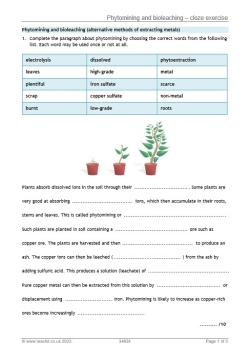Phytomining and bioleaching – cloze exercise

A gap-fill worksheet for GCSE chemistry students on how the biological methods of phytoextraction/phytomining and bioleaching can be used to extract metals from low-grade ores. The gapped texts also include comparisons of these extraction methods with traditional methods of mining metals in terms of time, cost and environmental impact.
This worksheet is suitable for the AQA unit on ‘Using resources’ or the OCR B chapter on ‘Chemicals of the natural environment’.
Answers are included.
Extracts from the answers:
Phytomining
The copper ions can then be leached (dissolved) from the ash by adding sulfuric acid. This produces a solution (leachate) of copper sulfate. Pure copper metal can then be extracted from this solution by electrolysis or displacement using scrap iron.
Bioleaching
In bioleaching, bacteria feed on these ores to obtain energy from the ore and in doing so oxidise the sulfide ions of the ore to sulfate ions, which dissolve to form sulfuric acid. This acid then dissolves other metal ions in the soil, and these are then absorbed by the plant.
